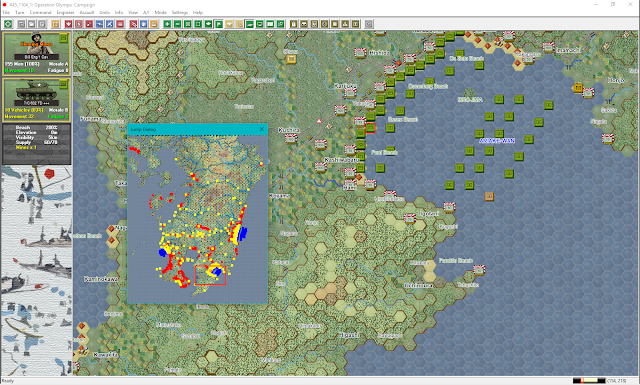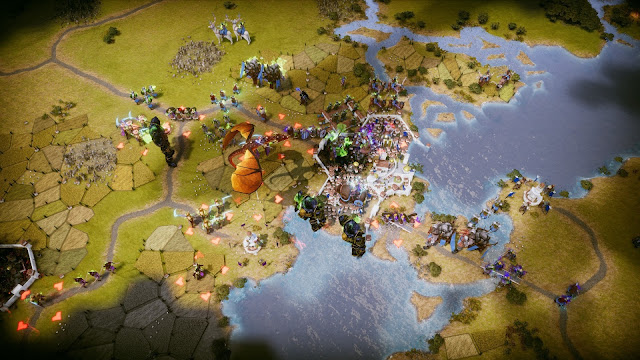What happens when you take a developer known for their deep, yet utterly arcane historical strategy games, and link them with a publisher known for making wargaming accessible to the masses? You get Field of Glory Empires, a rich grand strategy title that carves out its own space in the genre.
At a glance, one could quickly draw comparisons to the Total War or Paradox grand strategy games, but Empires sets itself apart with multiple mechanics that address some of the shortcomings of those series. One wholly unique feature of Empires is the way it integrates with a completely separate game, Field of Glory II, to allow you to play out the battles in that game. Though I must immediately point out that having Field of Glory II is by no means necessary to enjoy Empires. In fact, you probably won't want to command every battle personally, since that would add hours and hours to a campaign. However, if you already own Field of Glory II, and enjoy grand strategy games, it makes a whole lot of sense to get Empires. Suddenly, those fun tactical battles, the results of which were mostly inconsequential, take on significant weight. Now you are defending your capitol from an invading army, or fighting to claim a critical new province for your empire. Some may balk at the idea of needing two different games to get the "full" experience, but each can be had for much less than a typical $60 game, and both are worthwhile on their own, so I think it is reasonable enough.
Now, back to Empires itself. The basics of the grand strategy genre are mostly here. You begin the game by selecting one of dozens of different ancient tribes and civilizations. All your ancient favorites are here, from Rome and Carthage to the Greek city states and the "barbarian" tribes of Europe, and many more. The map spans all of Europe, North Africa, and stretches east to cover a portion of India. The standard campaign runs from 310 BCE to 190 CE. This is a lovely starting point just after the death of Alexander the Great and before the Punic Wars. Rome is on the rise, but many older civilizations are still lingering, their historical decline still a bit in the future. And that concept of rise and decline is a core theme of the game.
Unlike in many other similar games, simply painting the map your color will not lead to victory in Empires. As the Romans and many empires before and after them can attest, growing too large leads to many problems. In many cases, an empire that reaches a certain size will inevitably experience a rapid and sometimes total collapse. However, despite their complete collapse we still discuss and often think highly of the Romans today, almost 2000 years later. They left quite the legacy, didn't they? That is how victory is measure in Empires - how many "Legacy" points you are able to accumulate before the end of the game. Legacy points can be gained in many ways, and only lost in one or two ways. However, many of the ways you accumulate Legacy will also earn you "Decadence" points. This can be countered by focusing your resources on things that generate "Culture" points. Too much decadence leads to unrest, revolts, civil war. Countering those problems gets more difficult as your state grows larger and gets older.
 |
| The Emerald Isle makes for a nice "Tutorial Island" to learn the basics. |
It's a bit difficult for me to explain succinctly, but the long and short is this: Empires uses several core mechanics to capture a story that has played out so many times in history. Powerful states tend to rise out of obscurity, build themselves up to great heights, and then collapse more from internal rot than from outside aggression. I definitely recommend cracking open the player manual and reading through the relevant sections, as it's a bit obscure how it all works at first. The game does have in-game tutorials and a helpful glossary that will teach you everything else without much trouble. However, you will initially be at a loss as to the importance of progress/decline tokens, Culture-Decadence Ratios, Loyalty, and Legacy points if you don't at least skim through the manual. The manual also has a lengthy strategy guide section and designer's notes that explain the reasoning for the mechanics in the game, so it's well worth your time.
As an example, winning battles and raiding enemy provinces will sometimes net you slaves that you can distribute into your provinces. These slaves will naturally have a high level of unrest and always be a potential source of rebellion. Likewise, taking control of peoples who are ethnically different from you will lead to them being less than happy with their new rulers. The larger your population in a region, the greater their unrest will become as well. Much of this can be mitigated by building things like circuses and gladiator arenas, but these buildings grow your decadence score. As you slide from, let's say, a meritocratic republic built on duty and honor, into a bloated empire dependent on bread and circuses to keep people happy while slaves do all the work, the risk of revolt and civil war will grow despite your best efforts. It's a wonderful system that naturally responds to your actions and pushes your empire into the logical consequences.
As to the less abstract and more "day-to-day" mechanics of the game, any veteran grand strategy player will easily be able to hop in and get going with minimal fuss. The map is broken up into hundreds of provinces, and depending on who you are playing as, you will start with anywhere from one province to a couple dozen under your control. Within each province there is a population under your control. Population is represented by blocks of manpower that you can shift around to focus on food, infrastructure, money, or culture production. You can also construct buildings that will enhance production of those four resources. One interesting note in Empires is that you can only construct one building a time in a province, and you can only select what you want to build from an ever changing pool of options (one building per resource). If you don't like your current pool of options, you'll have to waste several turns rolling a new one. This creates an interesting strategic dilemma. I only have a very limited number of building slots in this province, and I really want to build XYZ, but it hasn't come up as an option yet. Do I spend several turns to see if it comes up next time, or do I go with Plan B right now? I'm not sure how historically accurate the concept is, but I found it refreshing to not use the same cookie cutter build order in every province like you would in other grand strategy games.
 |
| Each icon on the map indicates a special trade good in that province. |
The military side of things should be familiar enough to most strategy gamers. If you have ever played an AGEOD game before, you will immediately recognize the how all of this works, but be relieved to find that things are very simple this go around. Various unit types (skirmishers, infantry, and cavalry of all variety are available) are built in a region and then combined to create an army. Every unit has strengths and weaknesses, special perks like performing better in specific terrain, and each individual unit has an experience level that rises as they survive battles. On your turn you assign an army to move here and there, and give them a "stance" such as simply moving about, or immediately assaulting any forts they come across, or to go raiding neighboring provinces. Units don't actually move until you hit the end turn button, at which time ALL units from every state move at once. This means you could miss that enemy army you were targeting, or blunder into one you weren't aware of.
When two armies meet, a battle commences. As I mentioned above, you can opt to take direct control if you own Field of Glory II, and play the battle out there. This is a mostly seamless process, as Empires closes, Field of Glory II opens, and you hit a button to import the battle. Then the reverse occurs and you are right back in Empires with the battle result. Otherwise, the battle plays out in Empires with no real direct input from you. Your input is in how you decide to compose your army, and where you send them to fight. Army composition is far more engaging than in something like Europa Universalis, as unit types are far more distinct, and your army will very much reflect the empire you have built. Most units require that you have access to particular trade goods or meet other requirements. Additionally, almost every province can produce some variety of unique unit, that is better than its standard counter-part and often has extra perks, but is also more expensive. I really liked this feature, as it gives historical flavor to an army raised in any particular region.
So that hits all the highlights, but don't be mistaken, there are plenty of additional nitty-gritty details that I didn't get into, but you can learn about as you play. I want to reiterate how genius the victory point system is in this game. Because your legacy points remain in place even if your once great empire collapses, it's entirely possible to win the game while NOT being the biggest blob of color on the map. You can play through the rise, the golden age, and then the decline and fall of an empire, and still win the game. A fall is not guaranteed, of course, but the mechanics of the game will push you further and further in that direction unless you prove yourself a very capable leader.
The deep and interesting designs of developer AGEOD have finally evolved into a game system that anyone can play (without an excessive amount of head scratching), and it is a great moment that bodes well for their future. Despite going up against some of the most popular grand strategy games out there, I think Field of Glory Empire really shines as a fresh take on the genre. The Culture and Decadence system fleshes out an idea that is usually relegated to a simple "happiness" score in other games, and makes it the core of the gameplay loop. This completely changes how you think about building and managing your empire, and makes the plausible scenario, that your empire eventually crumbles, still be a fun part of the game. I give a strong recommendation to Field of Glory Empires, and it's a real no-brainer if you already own Field of Glory II, as both games benefit from combining the two.
Field of Glory Empires can be purchased directly from Slitherine, as well as on Steam and GoG.
(As of this writing it's 10% off, go grab it if you are interested!)
- Joe Beard

































Follow Us